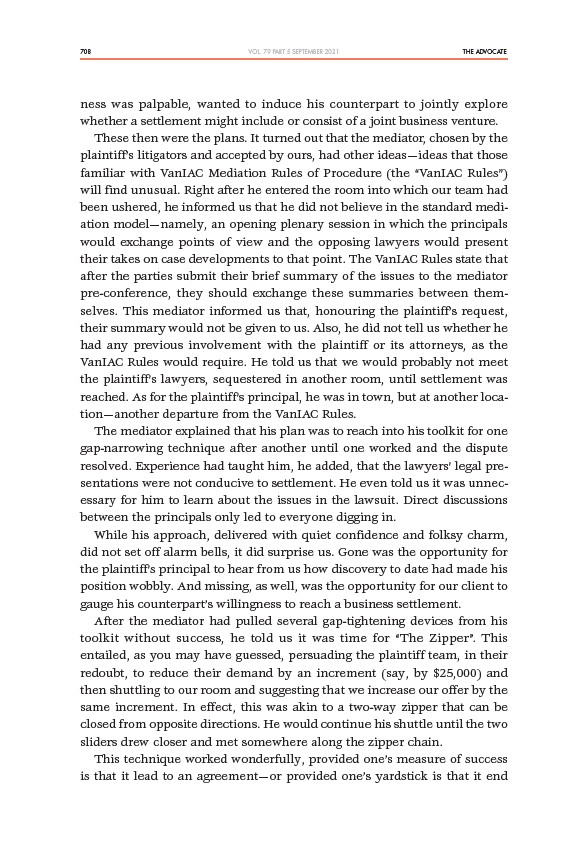
708 THE ADVOCATE
VOL. 79 PART 5 SEPTEMBER 2021
ness was palpable, wanted to induce his counterpart to jointly explore
whether a settlement might include or consist of a joint business venture.
These then were the plans. It turned out that the mediator, chosen by the
plaintiff’s litigators and accepted by ours, had other ideas—ideas that those
familiar with VanIAC Mediation Rules of Procedure (the “VanIAC Rules”)
will find unusual. Right after he entered the room into which our team had
been ushered, he informed us that he did not believe in the standard mediation
model—namely, an opening plenary session in which the principals
would exchange points of view and the opposing lawyers would present
their takes on case developments to that point. The VanIAC Rules state that
after the parties submit their brief summary of the issues to the mediator
pre-conference, they should exchange these summaries between themselves.
This mediator informed us that, honouring the plaintiff’s request,
their summary would not be given to us. Also, he did not tell us whether he
had any previous involvement with the plaintiff or its attorneys, as the
VanIAC Rules would require. He told us that we would probably not meet
the plaintiff’s lawyers, sequestered in another room, until settlement was
reached. As for the plaintiff’s principal, he was in town, but at another location—
another departure from the VanIAC Rules.
The mediator explained that his plan was to reach into his toolkit for one
gap-narrowing technique after another until one worked and the dispute
resolved. Experience had taught him, he added, that the lawyers’ legal presentations
were not conducive to settlement. He even told us it was unnecessary
for him to learn about the issues in the lawsuit. Direct discussions
between the principals only led to everyone digging in.
While his approach, delivered with quiet confidence and folksy charm,
did not set off alarm bells, it did surprise us. Gone was the opportunity for
the plaintiff’s principal to hear from us how discovery to date had made his
position wobbly. And missing, as well, was the opportunity for our client to
gauge his counterpart’s willingness to reach a business settlement.
After the mediator had pulled several gap-tightening devices from his
toolkit without success, he told us it was time for “The Zipper”. This
entailed, as you may have guessed, persuading the plaintiff team, in their
redoubt, to reduce their demand by an increment (say, by $25,000) and
then shuttling to our room and suggesting that we increase our offer by the
same increment. In effect, this was akin to a two-way zipper that can be
closed from opposite directions. He would continue his shuttle until the two
sliders drew closer and met somewhere along the zipper chain.
This technique worked wonderfully, provided one’s measure of success
is that it lead to an agreement—or provided one’s yardstick is that it end